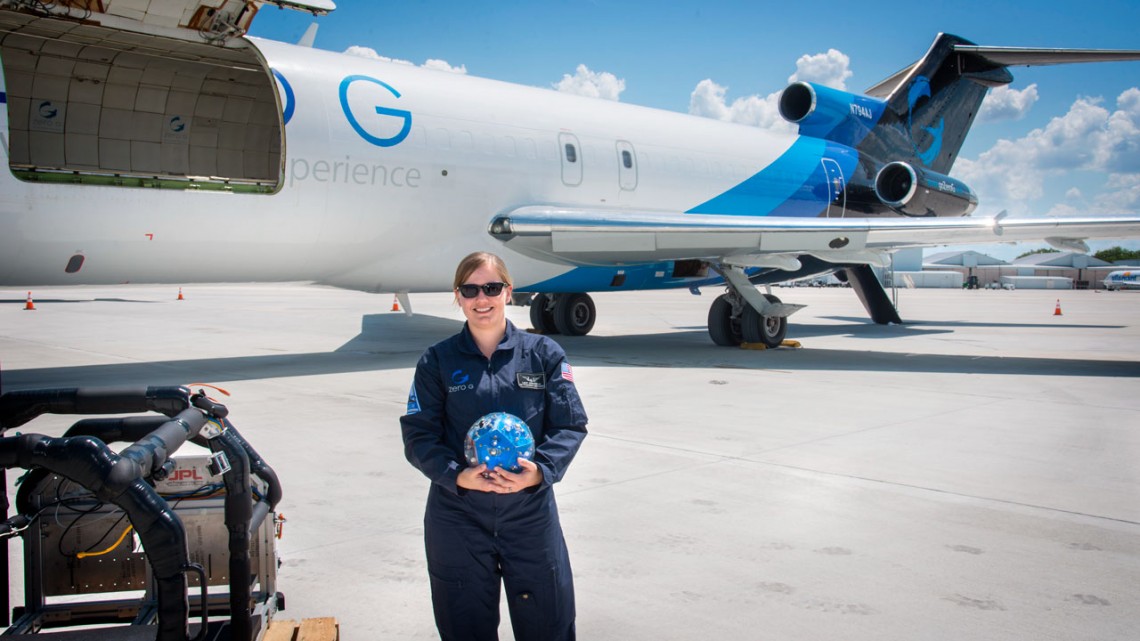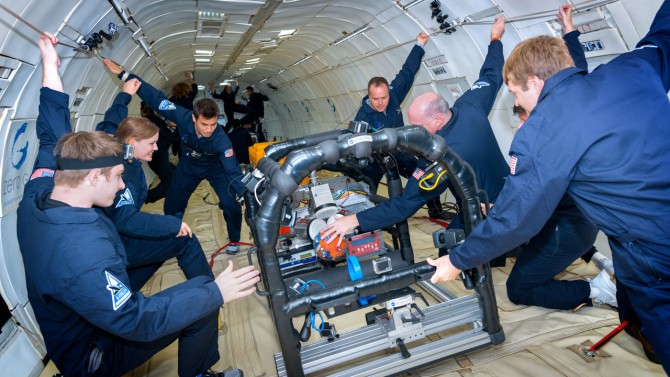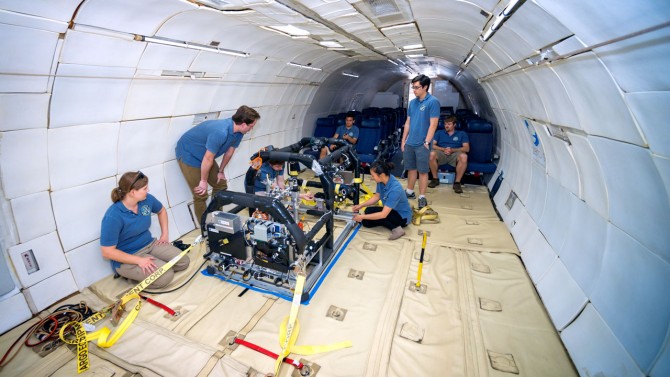
Laura Jones-Wilson, Ph.D. ’12, stands in front of a modified Boeing 727 used by NASA to conduct microgravity experiments.
From Cornell to NASA to an icy moon of Jupiter
By Olivia Hall
Laura Jones-Wilson, M.S. ’10, Ph.D. ’12, has long had her sights set on outer space.
“I learned about space at an Earth Day celebration when I was 5, and as soon as I found out that people had left the planet, I was like, ‘I’m in, let’s do this!’,” she remembers. “I got the word ‘aerospace engineer’ from watching ‘Star Trek’ episodes, and by early middle school, that’s what I was convinced I was going to be.”
That enthusiasm and determination have carried Jones-Wilson, who conducted her graduate research at Cornell’s Sibley School of Mechanical and Aerospace Engineering (MAE), right to the forefront of space exploration. At NASA’s Jet Propulsion Laboratory (JPL) in Pasadena, California, she serves as the payload verification and validation lead for the Europa Clipper mission, expected to launch in the mid-2020s. Jones-Wilson ensures that a variety of scientific instruments are properly tested and ready to study the surface of an icy moon of Jupiter as the 20-foot-high spacecraft makes about 45 close passes to determine whether the moon is habitable.
“There’s a certain romance about aerospace engineering,” Jones-Wilson says. “Space lets us see how small we are in the universe and the variety of worlds that are out there. Many of us in the industry are really taken by the idea of the ‘exploring the final frontier.’”
Jones-Wilson is one of dozens of Cornell alumni who work at NASA, the products of the university’s cross-campus focus on astronomy. Robert Pappalardo ’86, who received a bachelor’s in geology from the College of Arts and Sciences (A&S), is also working on the Europa Clipper mission, as the project scientist. Lauren DeFlores ’02 (A&S) is systems engineer on the rover Perseverance’s spectrometer instrument now looking at fine-scale minerology and organic compounds on Mars.
And Jason Hofgartner, M.S. ’14, Ph.D. ’16, (A&S) examines present-day active geologic processes in the outer solar system for JPL.
Jones-Wilson got her introduction to the problem-solving skills required to work at the edge of the unknown during her undergraduate years at Virginia Tech, through internships at NASA’s Wallops Flight Facility in Virginia and the Ames Research Center in California.
“These NASA internships cultivated a can-do attitude and willingness to ‘MacGyver’ a project into working,” Jones-Wilson said.
She brought both to her doctoral work at Cornell. She was attracted not only by the opportunity to work with her adviser, Mason Peck, the Stephen J. Fujikawa ’77 Professor of Astronautical Engineering, whom she calls “a visionary in the field,” but also by a supportive student body that shared her love for tackling challenges with teamwork. “Ithaca’s gorges also helped,” says Jones-Wilson, who enjoys hiking, biking and skiing.
Armed with funding from the National Science Foundation and the National Defense Science and Engineering Graduate Fellowship program, Jones-Wilson was free to explore a wide range of projects and technologies with Peck, from small satellites to control moment gyroscope steering laws. For her dissertation, she studied how the phenomenon of magnetic flux pinning might enable spacecraft to maintain close proximity and a specific orientation without mechanical contact.
“When a type-II superconductor interacts with magnets,” she says, “you can build a magnetic potential well that maintains a stable, preselected relative position and orientation between the magnet and superconductor. We can use this phenomenon to levitate the magnet against a gravity field on Earth, but in space we can use the fact that the effect works in all six degrees of freedom to maintain relative position and orientation between spacecraft without the need for an active control system.”
Drawing on rich talent pool
Jones-Wilson built spacecraft analogues to collect data and better model the flux pinning interface. After first hovering them on a testbed consisting of a sheet of glass with compressed air, she expanded her tests to two microgravity flights at NASA’s Johnson Space Center in Houston, Texas, where a modified aircraft temporarily creates a space-like experience of weightlessness during freefall dives from around 30,000 feet.
“When you’re not constrained by gravity in the same way,” she says, “you can actually measure the subtle cross-coupling in the dynamics across degrees of freedom that we were looking to characterize in this interface.”
To make it happen, Jones-Wilson drew on a broad pool of undergraduate and master’s-level talent at Cornell’s College of Engineering – from experts at soldering and machining to students focusing on mechanical and electrical design.
“I think at one point I had 20 students working for me,” she says, “and we were all focusing on different parts of the project. I couldn’t have done it without those teams. It was really empowering to have access to such smart people who were all really interested in the research.”
Jones-Wilson was benefitting from a type of experiential learning that Peck calls a hallmark of Cornell’s programs in aerospace engineering. “As an undergraduate, you might expect your time here to include four years – or maybe more if you stick around for the M.Eng. degree – of continuous engagement in a particular project, which I think is rare,” he says, noting students get to contribute and take on leadership positions at the level of their abilities, regardless of seniority.
As a graduate student, Jones-Wilson “really took ownership of her project,” Peck recalls. “Part of our mission here in advising Ph.D. students is to give them the freedom to be successful – or, I suppose, to fail – on their own terms. And Laura’s tendency to just go ahead and wrestle a problem to the ground is clearly one of her strengths.”
Jones-Wilson also took advantage of the close relationships between MAE and Cornell’s Department of Astronomy in the College of Arts and Sciences. For example, Peck points out, faculty regularly collaborate on large research ventures, and astronomers and engineers come together for summer programs on spacecraft projects.
Like many aerospace engineering doctoral students, Jones-Wilson took classes such as optical astronomy and planetary science, and invited Terry Herter, a professor in the Department of Astronomy, to sit on her special committee.
“Having access to a world-class engineering program and world-class scientists in one space makes Cornell unique,” she says. “It’s the perfect incubator for what JPL, in particular, is looking for: scientists who understand engineering, and engineers who understand science.”
Getting a foot in the door
For Jones-Wilson, these connections meant a foot in the door with her dream employer. A visit to Cornell by JPL leaders led to conversations, an interview and ultimately her first job at JPL.
For the first five years with NASA, she worked on guidance and control for small satellites.
“A lot of what I found most interesting was talking to the scientists about how to effectively get the science they wanted,” she recalls. She found herself looking increasingly for positions in systems engineering, which brought her to a number of different roles for the Europa Clipper mission.
Now, as the payload verification and validation lead, Jones-Wilson finds that her time at Cornell prepared her well for her job. “Being sensitized to a scientific point of view really enriches the work I do today,” she says.
For example, the team was having trouble translating the requirements for scientific data collection at Europa in a way that would allow systems engineers to make informed decisions about how to build the flight system. So Jones-Wilson and a colleague developed a framework for these conversations, a kind of “periodic table” of requirements. They mapped science objectives onto the way in which measurements were collected, revealing useful patterns for analysis and ensuring complete datasets.
“The framework ended up really successfully facilitating key science and systems engineering decisions across the whole project,” Jones-Wilson says. “It’s probably the work I’m most proud of to date.”
While Jones-Wilson enjoys her day-to-day work – talking to colleagues, writing code, conducting analyses and attending science lectures – what inspires her is how those efforts contribute to the project’s ultimate goals.
“Figuring out in meetings how you’re going to timestamp a data packet really does come out to, ‘How do you know if there’s a saltwater ocean under the ice shell of Europa? Is this a place that could have been habitable?’ There are a lot of cool questions we can answer if we get this right,” she says.
In time, she may advance to working as one of the JPL supervisors, who split their time between administration and engineering projects. “I could see myself doing that,” said Jones-Wilson.
So could her former doctoral adviser.
“The key features I’d say that make Laura successful are her dogged insistence on getting things right and being very detail-oriented and thorough,” Peck says. “She’s terrific as an organizational leader, and I’m confident that in the years to come she’ll continue to rise through the ranks of JPL or whatever organizations she finds herself part of.”
In addition to the Europa Clipper mission, Jones-Wilson is training to serve on JPL’s A-team, a brainstorming group of experts tasked to solve “crazy problems.” She also occasionally stops into the Small Satellites Dynamics Testbed that she co-founded at JPL with fellow Cornellian Swati Mohan ’04; continues to collaborate on projects with Peck; and helps to pave the path for the next generation of aerospace engineers.
“I’m really grateful to the Cornell community for all the opportunities they’ve given me, so I like mentoring students and bringing them over to do internships at JPL to see what it’s actually like to work on big engineering projects at the scale Clipper has,” Jones-Wilson says. “It’s what I wanted when I was 5 and thought about exploring the cosmos, and now here we are.”
Olivia Hall is a freelance writer for the College of Engineering. This article is adapted from the original, “Laura Jones-Wilson, Ph.D. ’12: From Cornell to NASA to an icy moon of Jupiter.”
Media Contact
Get Cornell news delivered right to your inbox.
Subscribe



